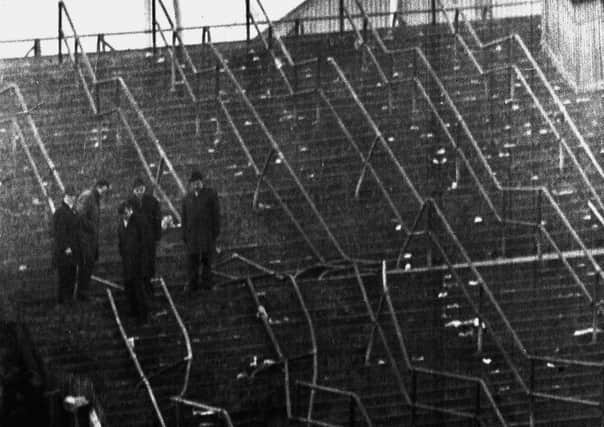The deaths of 66 football fans in Glasgow 50 years ago today shone a spotlight on the complacency of the authorities


The 50th anniversary of the Ibrox Stadium disaster in Glasgow is today.
The tragic deaths of 66 football fans following the New Year ‘Old Firm’ fixture between Rangers and Celtic represented the worst tragedy involving sports spectators in the British Isles until the Hillsborough disaster in 1989.
Advertisement
Hide AdAdvertisement
Hide AdI was part of the 80,000 crowd on the day having entered via ‘Stairway 13’ at the North-east corner of the ground.


After the match I exited from the opposite corner of the same terracing, a decision that might well have saved my life.
The disaster has been the subject of many published articles and broadcasts. In recent weeks commemorative pieces have appeared, and some of them have regrettably repeated inaccuracies and falsehoods, and perpetuated myths.
Some years ago I conducted research into the disaster. From the proceedings of the Fatal Accident Inquiry, and the Glasgow police records held at Strathclyde Regional Archives, a number of points clearly emerged.
Advertisement
Hide AdAdvertisement
Hide AdFirstly, there is almost certainly no basis for the much-circulated theory that the disaster was the result of departing fans turning back on hearing the roar that greeted a last-gasp Rangers goal, then colliding with fans leaving. This theory was most recently recycled in a feature article in a London newspaper.
The eyewitnesses who gave evidence at the inquiry – some of them residents of the tenement flats opposite the exit – overwhelmingly concurred that he accident was caused by fans at the top of ‘Stairway 13’ falling and pushing forward those in front of them, leading to the crushing and trampling which was the cause of the fatalities. ‘It was as if a hole had appeared in the ground,’ one said.
Eyewitnesses also agreed that this occurred several minutes after the end of the match. I personally recall that the great majority of fans in the ‘Rangers End’ terracing stayed to celebrate the goal after the final whistle.
Secondly, while there has rightly been reference made to a previous tragedy on the same stairway in 1961 when two people lost their lives, distortions of the facts have again been spread.
Advertisement
Hide AdAdvertisement
Hide AdThe inquiry into what happened in 1961 concluded that crowd pressure at the top of the stairs had been the crucial factor, and a police spokesman who gave evidence agreed that police in future should be stationed at the top of the terracing to control the exit of the fans.
This lesson was not taken on board, even after further incidents of crushing on the stairway in 1967 and 1969.
Thirdly, it should be noted that Rangers carried out adjustments to the staircase after the 1961 tragedy. Hand-rails were installed dividing the exit into seven passageways, and the steps were concreted. The terracing and exit steps of Scotland’s national stadium, Hampden Park, remained unconcreted well into the 1970s. However, although Rangers could not be blamed for the condition and maintenance of the staircase afterwards, too little thought was given to its design.
The exit was what was called a ‘waterfall staircase’, and during the inquiry into the 1971 disaster several experts took the view that the dangers inherent in such a structure might have been minimised by altering the design to create a ‘fanning out’ effect near the bottom, or by reconstructing the stairway into a ‘zig zag’ style with regular turning points.
Advertisement
Hide AdAdvertisement
Hide AdThe victims of the disaster were overwhelmingly adult male manual workers. Their occupations reflected Glasgow and West-Central Scotland’s heavy industrial character, so akin to that of Belfast, and indicated the extent to which football remained the working man’s leisure pursuit in the 1970s.
There were welders, platers, panelbeaters, machine operators, sheet metal workers, plumbers, electricians, boilermakers, and fitters. There were several young apprentices of various trades. There was one female victim: an 18-year-old machinist from Stirlingshire.
Particularly heart-rending were the deaths of five teenage boys, all school friends, from the village of Markinch in Fife, and a nine-year-old boy from Liverpool.
The Ibrox disaster’s impact reverberated throughout the Scottish diaspora. It also profoundly affected the thousands of Rangers supporters in Northern Ireland, just as the ‘Troubles’ were taking their most lethal turn.
Advertisement
Hide AdAdvertisement
Hide AdThe disaster brought to light the complacency regarding safety at football matches on the part of the clubs and the authorities. A police witness at the inquiry made the following statement: ‘There is always crushing leaving football matches, normal rushing, they seem to enjoy it and can take it.’
No legislation was passed in this period to force clubs to take safety measures. Government left such matters to the football authorities who in turn passed them on to the clubs themselves. At this time there was no consensus of opinion in Britain regarding standards of ground safety, while in Scotland the authorities habitually confused the issues of crowd behaviour and safety and were fixated on the law and order issues surrounding the ‘Old Firm’ rivalry.
The disaster prompted Rangers to begin a reconstruction job on Ibrox lasting over a decade, and the stadium became virtually all-seater long before Hillsborough forced English clubs to follow suit.
The 66 who perished in 1971 will be remembered in an appropriate fashion before the next Rangers v Celtic match at Ibrox exactly 50 years to the day.
Advertisement
Hide AdAdvertisement
Hide Ad• Graham Walker is Professor of Political History at Queen’s University Belfast
——— ———
A message from the Editor:
Thank you for reading this story on our website. While I have your attention, I also have an important request to make of you.
With the coronavirus lockdown having a major impact on many of our advertisers — and consequently the revenue we receive — we are more reliant than ever on you taking out a digital subscription.
Subscribe to newsletter.co.uk and enjoy unlimited access to the best Northern Ireland and UK news and information online and on our app. With a digital subscription, you can read more than 5 articles, see fewer ads, enjoy faster load times, and get access to exclusive newsletters and content. Visit https://www.newsletter.co.uk/subscriptions now to sign up.
Advertisement
Hide AdAdvertisement
Hide AdOur journalism costs money and we rely on advertising, print and digital revenues to help to support them. By supporting us, we are able to support you in providing trusted, fact-checked content for this website.
Alistair Bushe
Editor